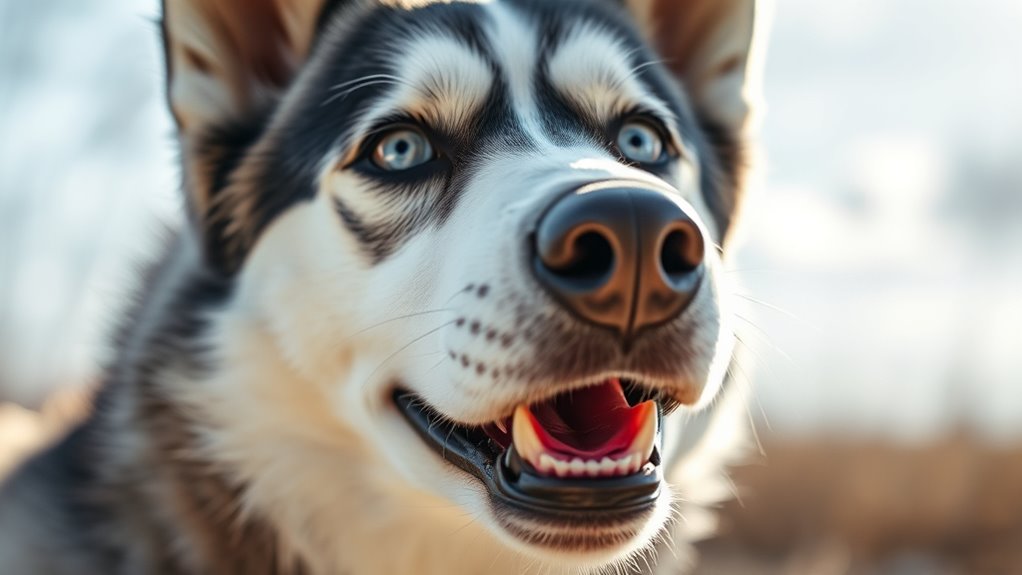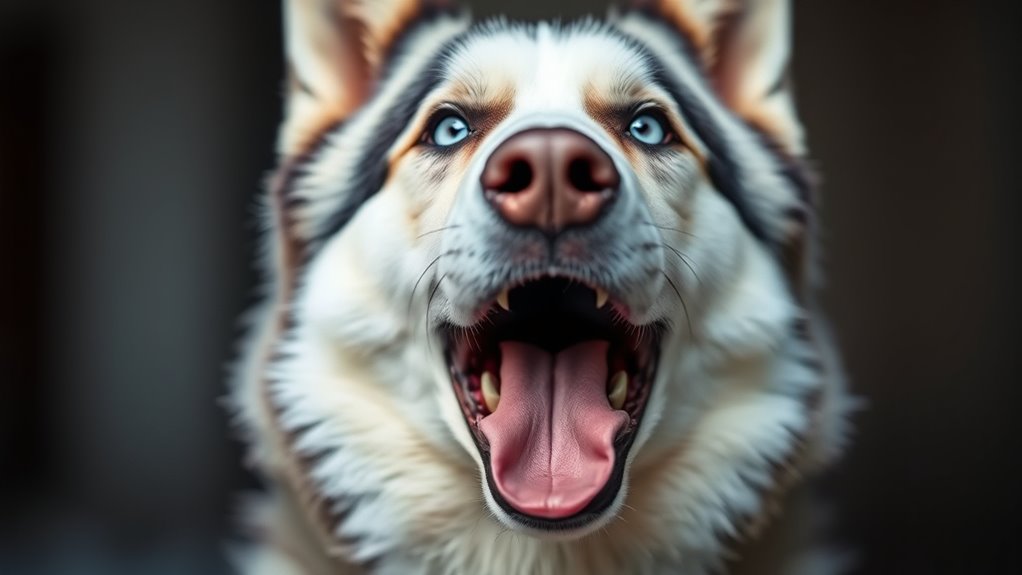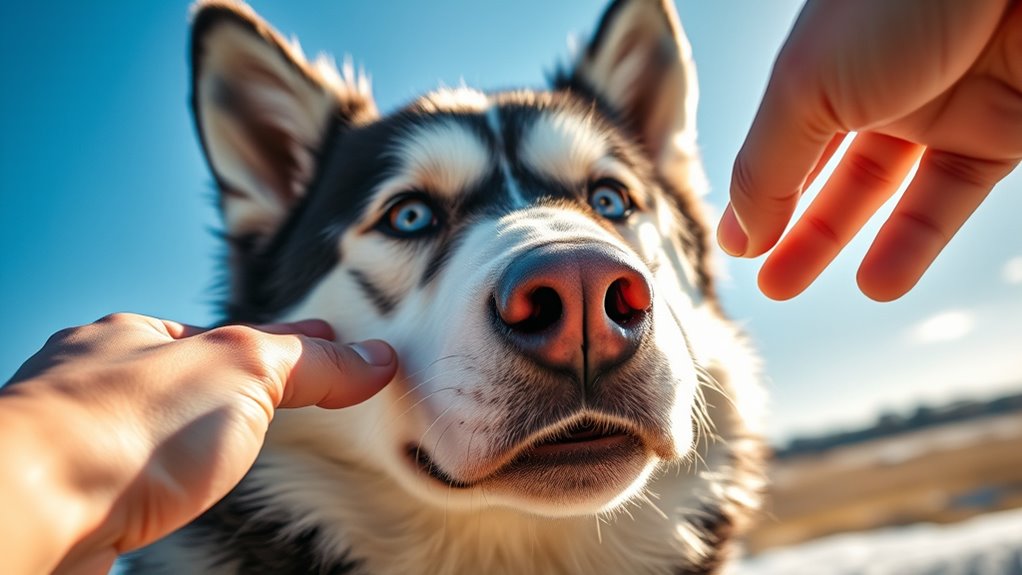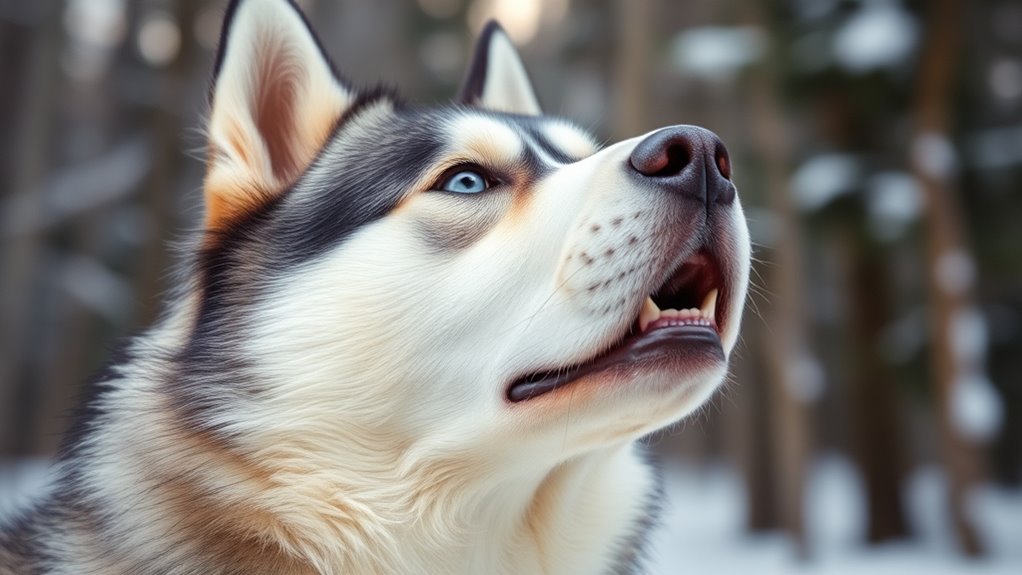Siberian Huskies use a variety of vocalizations to communicate their feelings and needs. You might hear barking, playful yelps, howls, whines, and chatter—each with specific meanings. For example, howling often signals loneliness or excitement, while whining can indicate anxiety or a desire for attention. Understanding these sounds and their body language helps you respond better. Keep exploring, and you’ll discover more about decoding your Husky’s unique vocal cues.
Key Takeaways
- Husky vocalizations include barking, yelping, howling, whining, and chatter, each conveying different emotions or needs.
- Howling often signals loneliness, excitement, or warning, and tone and context are essential for accurate interpretation.
- Whining and whimpering indicate discomfort, anxiety, or pain, requiring careful observation of body language.
- Unique vocal traits like melodic howling and playful yips reflect Huskies’ sled dog heritage and expressive nature.
- Effective communication involves observing vocal cues, body language, and using positive reinforcement to strengthen understanding.
The Different Types of Husky Sounds

Siberian Huskies are known for their wide range of vocalizations, each serving a different purpose. You’ll notice husky barking, which can be loud and sharp, often used to alert or communicate with you. It’s not aggressive but rather a way for them to get your attention or express excitement. Playful yelping is another common sound, especially during playtime or when they’re happy. This yelp is higher-pitched and energetic, showing their enthusiasm. Huskies also use these sounds to bond with you, letting you know how they feel. Their vocal variety allows them to communicate complex emotions and needs. Paying attention to these noises helps you understand whether your husky is alert, playful, or simply seeking companionship. Additionally, understanding vocal communication can enhance your bond and improve your ability to respond to your husky’s needs. Recognizing the context of these sounds can also help in behavioral understanding, training, and developing a stronger human-animal connection. For example, their vocalizations may also reflect emotional states, giving insight into their overall well-being. Recognizing subtle variations in tone can help you better interpret their emotional cues.
What Husky Howling Really Means

Husky howling is more than just a loud noise; it’s a meaningful form of communication. When your Husky howls, they’re expressing their feelings, alerting you to something, or seeking connection. Their howling can indicate loneliness, excitement, or even a warning. To understand these signals, you need to pay attention to the context and tone. During vocalization training, you can teach your Husky to control their howling, reducing unnecessary noise. Imagine your Husky:
- Howling at the moon, longing for the pack
- Vocalizing when they sense danger nearby
- Howling with excitement during playtime
- Responding to your calls or other sounds
- Expressing loneliness when left alone
Understanding the importance of correct issuer selection can help ensure your Husky’s communication remains healthy and controlled. Recognizing what Husky howling really means helps improve Husky communication and strengthens your bond. Proper training can also incorporate positive reinforcement techniques to encourage desirable vocal behaviors, ensuring their howling becomes a meaningful, controlled part of your relationship.
Interpreting Whining and Whimpering

Whining and whimpering are subtle ways your dog communicates discomfort or needs, often signaling more than just noise. These vocal expressions are key parts of dog communication, revealing their emotional state or physical condition. When your Husky whines, it could mean they’re anxious, seeking attention, or hungry. Whimpering often indicates pain or fear, prompting you to check for underlying issues. Pay close attention to the context and your dog’s body language to interpret these signals accurately. For example, a soft whimper when you leave the room might signal separation anxiety, which is common in Huskies. Recognizing these subtle cues helps you respond appropriately and strengthen your bond. Understanding canine emotions can further improve your ability to interpret these vocal cues effectively. Observing the environment and your dog’s overall demeanor can provide additional clues to their needs, especially since environmental interactions play a significant role in their emotional well-being. Additionally, being attentive to body language alongside vocalizations can give a more comprehensive understanding of your Husky’s current state.
Unique Vocal Traits of Siberian Huskies

One of the most distinctive features of Siberian Huskies is their wide range of vocalizations, which often go beyond typical dog sounds. These vocal traits reflect their sled dog history, making them expressive and unique. Huskies communicate with a variety of sounds, including howls, yips, and chatter, often accompanied by husky body language that signals excitement or alertness. You might notice:
- A musical, almost talking, howling that echoes their sled dog roots
- Playful yips during energetic moments
- Soft murmurs when seeking attention
- Melodic chatter when interacting with you
- Deep, resonant calls to communicate with pack members
These sounds help you understand their mood, while their body language adds nuance, revealing whether they’re happy, anxious, or alert. Recognizing the frequency of vocalizations can deepen your bond and improve communication with your husky. Additionally, understanding their vocal patterns can help in interpreting their emotional state, fostering a stronger connection and better care.
Tips for Communicating With Your Husky

Understanding your Siberian Husky’s unique vocal signals and body language is key to effective communication. To do this, observe their cues closely and respond consistently. Use positive reinforcement training techniques to encourage desired behaviors and reduce misunderstandings. Socialization tips are also crucial; expose your Husky to different people, animals, and environments early on to build confidence and clarity in communication. When your Husky vocalizes, pay attention to the tone and context—these often reveal their emotions or needs. Be patient and calm, as Huskies respond best to gentle guidance. Clear, consistent signals help your dog understand what you expect, strengthening your bond. Recognizing the distinguishing traits of Huskies can also aid in interpreting their vocalizations accurately. Additionally, understanding AI in Education advancements can help owners utilize training tools more effectively. Developing an understanding of vocalization patterns can further improve your communication skills with your Husky. Remember, communication is a two-way street, so take the time to listen and interpret your Husky’s vocal and body language cues. Building awareness of behavioral cues can enhance your ability to respond appropriately and nurture a trusting relationship. Moreover, paying attention to sleep and dreams can provide insights into your Husky’s vibrational state and overall well-being.
Frequently Asked Questions
How Can I Tell if My Husky Is Anxious or Just Communicating?
You can tell if your husky is anxious or just communicating by observing their body language and facial expressions. Anxious huskies often display signs like pacing, trembling, pinned-back ears, and avoiding eye contact. If your dog’s body is tense or their facial expressions seem worried, they might be anxious. Conversely, relaxed body language and friendly facial expressions indicate they’re simply communicating or engaging with you. Pay attention to these cues to understand their mood better.
Do Huskies Have Different Vocalizations Based on Their Mood?
Think of your husky like an expressive actor on stage, using breed-specific sounds to convey mood. Yes, they have different vocalizations—whines, howls, buffs—that reflect feelings like excitement, fear, or territoriality. When your husky’s tail is high, and they’re vocalizing loudly, they might be asserting territory. Recognizing these cues helps you understand whether they’re happy, anxious, or protecting their space, much like a character revealing their emotions.
Can Huskies Learn to Control Their Vocalizations?
You can train your husky to control their vocalizations through consistent training techniques and vocal training. By using positive reinforcement, you teach them when it’s appropriate to bark or howl, helping them become more mindful of their sounds. Patience and regular practice are key, as huskies can learn to manage their vocal expressions over time. With dedication, you’ll notice improved control and a quieter, more obedient companion.
Are There Specific Sounds That Indicate Health Issues in Huskies?
Did you know that changes in your husky’s vocalizations can signal health warning signs? If your dog suddenly whines, yelps, or makes unusual sounds, it could indicate issues with vocal health or underlying problems like pain or discomfort. Pay attention to these specific sounds, as they often serve as early alerts for health issues. Recognizing these signals helps you seek prompt veterinary care, ensuring your husky stays happy and healthy.
How Do Huskies’ Vocal Cues Differ From Other Sled Dog Breeds?
You notice that huskies have unique breed-specific sounds and vocalization patterns compared to other sled dog breeds. While many sled dogs bark or yelp, huskies often communicate through distinctive howls, whines, and a mix of vocal cues. These breed-specific sounds help you understand their emotions better. Huskies’ vocalizations are more varied and expressive, making their communication style stand out among sled dogs, allowing you to interpret their needs more accurately.
Conclusion
Understanding your Siberian Husky’s vocalizations can deepen your bond and improve communication. While some believe their howls are just melodious expressions, others suggest they serve as complex messages of need or emotion. The truth is, Huskies are uniquely expressive, blending instinct and personality. By paying attention to their sounds, you’ll discover that every bark, whine, or howl has meaning—reminding us that true connection often comes from truly listening.










